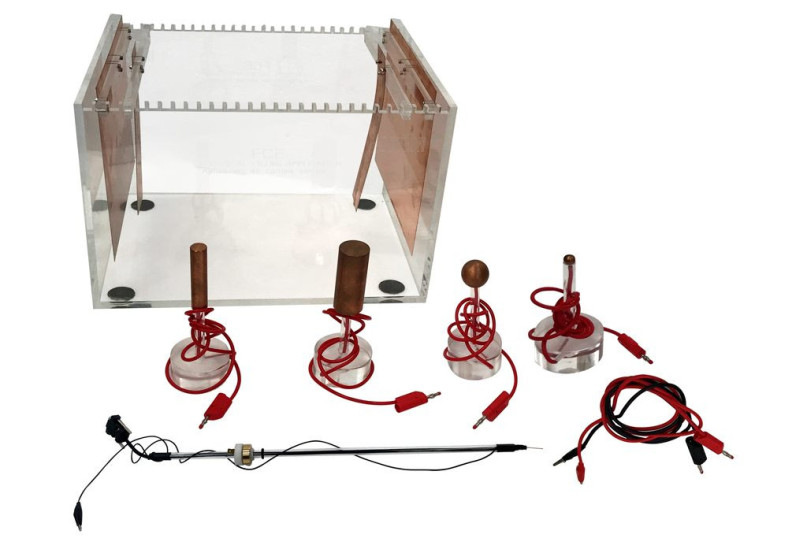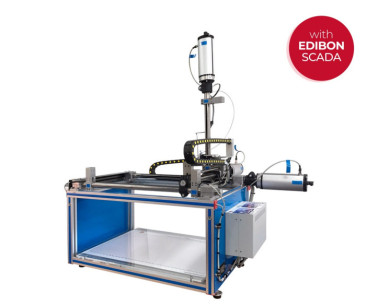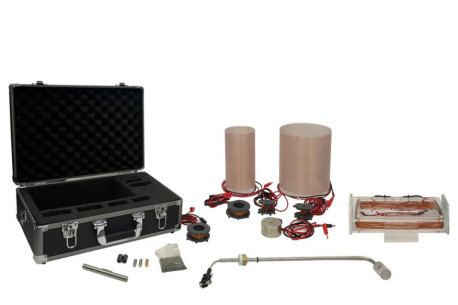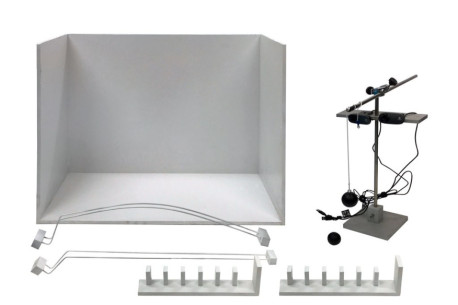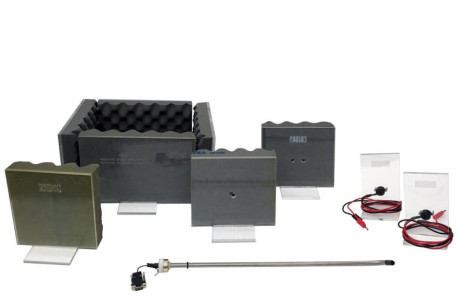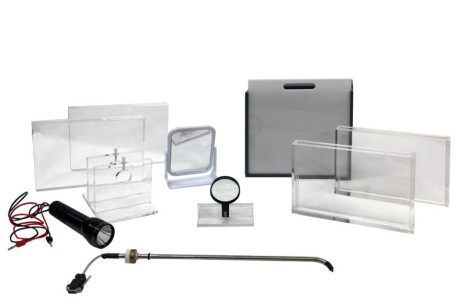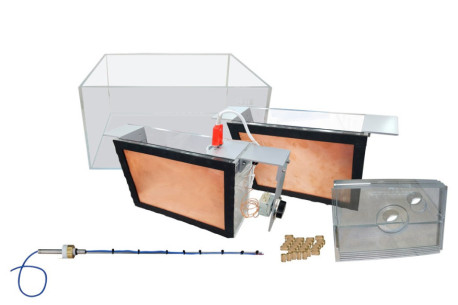FCE 電場研究セット
革新的なシステム
The Electric Fields Study Set, "FCE", allows the spatial study of the electric field in all its dimensions: calculation of the intensity, force lines, equipotential surfaces in both static and dynamic fields, giving the student a more extensive spatial vision not given by other methods.
拡張
研究室
関連ニュース
概要
The Electric Fields Study Set, "FCE", allows the spatial study of the electric field in all its dimensions: calculation of the intensity, force lines, equipotential surfaces in both static and dynamic fields, giving the student a more extensive spatial vision not given by other methods.
The supply of spheres, cylinders, wires and conducting planes together with charge sources allows the student to study experimentally Coulomb's law, the electric force between conducting spheres, Gauss's theorem and the principle of superposition. The calculation of the electric flux allows us to, experimentally determine the redistribution of charges generated in plane-parallel capacitors in series and parallel configurations. The effects of dielectrics on capacitors will be carried out using different materials: wood, glass and plastic blocks, which allow us to study series/parallel configurations.
The "FCE" consists of a robot arm to which is connected a probe capable of measuring the static and dynamic electric field strength. The control software together with the data acquisition board allows to perform sweeps in space storing the electric field intensity point by point with a maximum resolution of 1 mm. The Set is supplied with a management software specially designed for the spatial representation of the electric field strength and lines of force.
The mathematical tools of integration and derivation available in the control software allow the experimental verification of the laws, theorems and basic principles of electricity that are rooted in the theoretical plane and that, through the FCE Set, can be transferred to the experimental plane.
演習と指導の慣行
マニュアルに含まれるガイド付き実習
Level 1:
- Electric field created by two parallel flat sheets.
- Visualisation of the field lines created by a point charge.
- Spatial representation of the equipotential lines and the intensity of the electric field created by a point charge.
- Visualisation of the field lines generated by two point charges.
- Spatial representation of the equipotential curves created by two spherical charges.
Level 2:
- All the exercises included in level 1.
- Calculation of the charge enclosed by a plane-parallel capacitor. Gauss’s theorem (I).
- Experimental demonstration of Gauss’ law for a sphere and two conducting planes.
- Study of the charge stored in a plane-parallel capacitor as a function of the distance between the plates. Concept of capacitance.
- Spatial representation of the equipotential lines created by a cylinder and a conductive plane. Principle of superposition (II).
- Spatial study of the electric field created by a non-regular body. Edge effects.
- Visualisation and calculations of the intensity of the electric field generated by a plane-parallel capacitor with a dielectric sphere inside it. Dielectric (I).
- Spatial representation of the electric field and equipotential lines generated by introducing a conducting sphere into a planar-parallel capacitor. Superposition principle (III).
- Electric field lines and equipotential surfaces generated by two conducting spheres equidistant from a conducting plane. Image effect.
- Experimental calculation of the redistribution of charge and potential energy of a series and parallel configuration of two plane-parallel capacitors.
IMPORTANT: The teacher can use his own elements, so these practical possibilities are NEARLY UNLIMITED.
より実用的な練習をして、ユニットを完成させる
- Many students view results simultaneously. To view all results in real time in the classroom by means of a projector or an electronic whiteboard.
- Open Control, Multicontrol and Real Time Control. This unit allows intrinsically and/or extrinsically to change the span, gains, proportional, integral, derivative parameters, etc, in real time.
- The Computer Control System with SCADA allows a real industrial simulation.
- This unit is totally safe as uses mechanical, electrical/electronic, and software safety devices.
- This unit can be used for doing applied research.
- This unit can be used for giving training courses to Industries even to other Technical Education Institutions.
- Control of the EG5C unit process through the control interface box without the computer.
- Visualization of all the sensors values used in the FCE unit process.
- Several other exercises can be done and designed by the user.
補完的な機器
磁場研究セット
力学研究セット
音響学研究セット
光学研究セット
熱力学研究セット
品質

アフターサービス

 クッキーの設定
クッキーの設定

